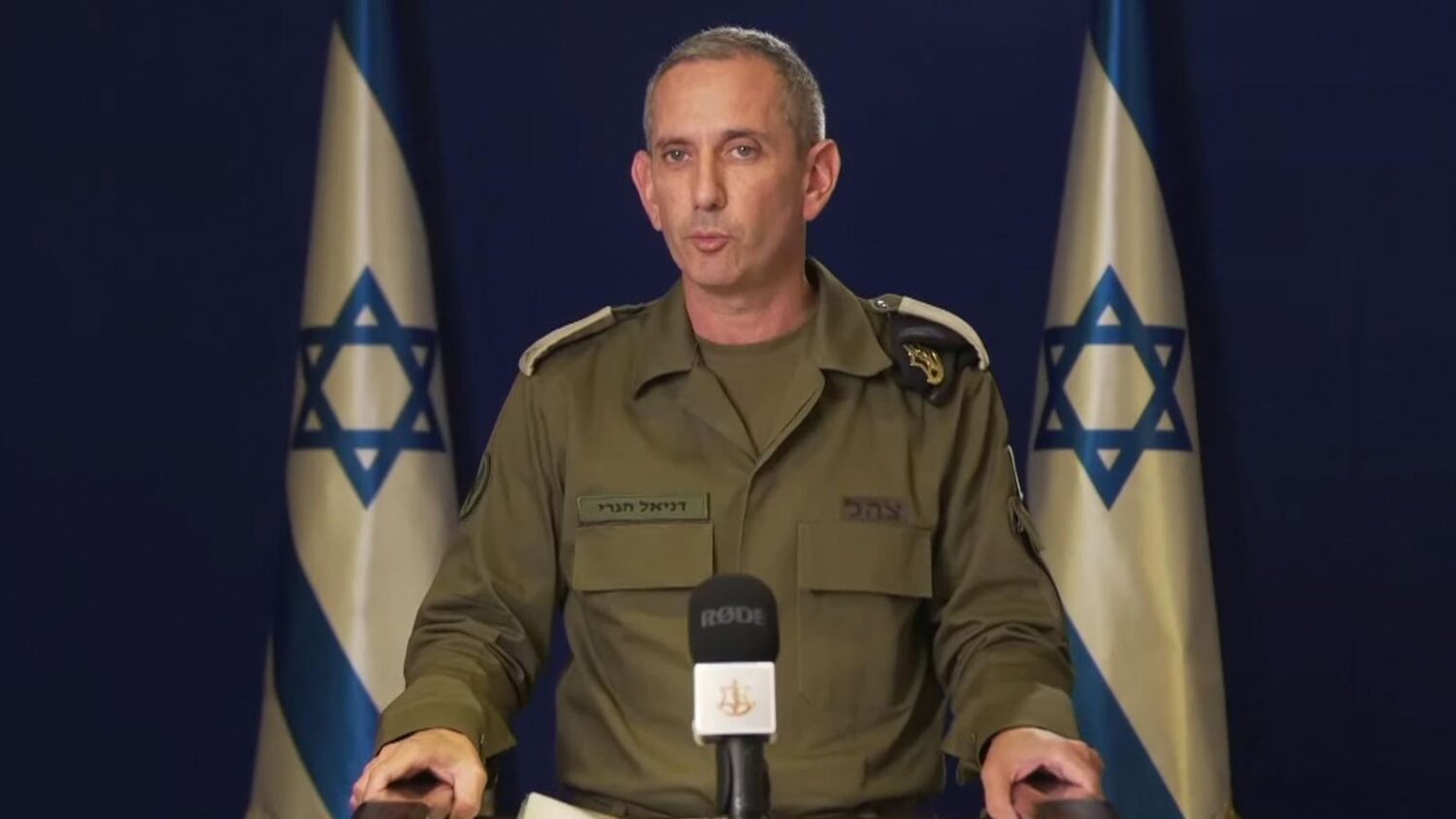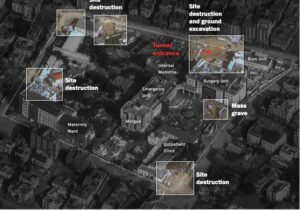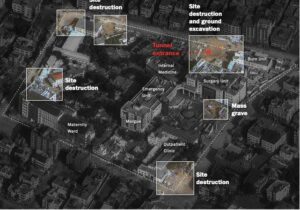The case of al-Shifa hospital – hasbara exposed

JVL Introduction
That there are tunnels under Al-Shifa hospital should surprise no-one, least of all Israel. It built large numbers of them when it was occupying Gaza directly.
But before the siege of Al-Shifa hospital IDF spokesman Daniel Hagari made some very specific allegations, viz that
- five hospital buildings were directly involved in Hamas activities;
- the buildings sat atop underground tunnels that were used by militants to direct rocket attacks and command fighters; and
- the tunnels could be accessed from inside hospital wards.
The assertions were backed by “concrete evidence”. Allegedly.
A Washington Post analysis, reposted below, shows:
- The rooms connected to the tunnel network discovered by IDF troops showed no immediate evidence of military use by Hamas.
- None of the five hospital buildings identified by Hagari appeared to be connected to the tunnel network.
- There is no evidence that the tunnels could be accessed from inside hospital wards.
The Post’s assessment is cautious in the extreme but with the best will in the world cannot find anything of substance to back up the IDF’s claims (see the original article for clips from IDF-released video “evidence”).
None of it amounts to more than a hill of beans in this crazy world.
Since this non-justification for the invasion of Al-Shifa, a string of other hospitals have become “legitimate targets” as Israel rewrites the rules of war, while Western powers look on and do nothing.
This article was originally published by the Washington Post on Thu 21 Dec 2023. Read the original here.
The case of al-Shifa: Investigating the assault on Gaza’s largest hospital
A Post analysis of open-source visuals and satellite imagery sheds light on the Israel Defense Forces’ claims about Hamas’s use of al-Shifa Hospital in Gaza City.
JERUSALEM — Weeks before Israel sent troops into al-Shifa Hospital, its spokesman began building a public case.
The claims were remarkably specific — that five hospital buildings were directly involved in Hamas activities; that the buildings sat atop underground tunnels that were used by militants to direct rocket attacks and command fighters; and that the tunnels could be accessed from inside hospital wards. The assertions were backed by “concrete evidence,” Israel Defense Forces spokesman Daniel Hagari said as he laid out the case in an Oct. 27 briefing.
After storming the complex on Nov. 15, the IDF released a series of photographs and videos that it said proved its central point.
“Terrorists came here to command their operations,” Hagari said in a video published Nov. 22, guiding viewers through an underground tunnel, illuminating dark and empty rooms beneath al-Shifa.
But the evidence presented by the Israeli government falls short of showing that Hamas had been using the hospital as a command and control center, according to a Washington Post analysis of open-source visuals, satellite imagery and all of the publicly released IDF materials. That raises critical questions, legal and humanitarian experts say, about whether the civilian harm caused by Israel’s military operations against the hospital — encircling, besieging and ultimately raiding the facility and the tunnel beneath it — were proportionate to the assessed threat.
The Post’s analysis shows:
- The rooms connected to the tunnel network discovered by IDF troops showed no immediate evidence of military use by Hamas.
- None of the five hospital buildings identified by Hagari appeared to be connected to the tunnel network.
- There is no evidence that the tunnels could be accessed from inside hospital wards.
Hours before IDF troops entered the complex, the Biden administration declassified U.S. intelligence assessments that it said bolstered Israel’s claims. In the aftermath of the raid, Israeli and U.S. officials have stood firm behind their initial statements.
“We are absolutely confident in the intelligence … that Hamas was using it as a command and control node,” a senior administration official told The Post last week, speaking on the condition of anonymity to discuss sensitive findings. “Hamas had been holding the hostages in the hospital compound until shortly before Israel went in.”
The U.S. government has not made any of the declassified material public and the official would not share the intelligence this assessment was based on.
“The IDF has published extensive, irrefutable evidence that points to the abuse of the Shifa hospital complex by Hamas for terrorism purposes, and underground terrorism activity,” an IDF spokesperson told The Post.
When asked if more evidence from al-Shifa would be forthcoming, the spokesperson said: “We cannot provide additional information.” On Nov. 24, Israel’s military announced in a statement that it had destroyed the tunnel on the hospital grounds; its forces withdrew soon after.
“Before, I was convinced that [al-Shifa] was where these operations were taking place,” a senior U.S. member of Congress told The Post, speaking on the condition of anonymity because of the sensitivity of the matter. But now, he said, “I think there has to be a new level of demonstration. They should have more proof at this point.”
The targeting by a U.S. ally of a compound housing hundreds of sick and dying patients and thousands of displaced people has no precedent in recent decades. The march on al-Shifa caused the hospital’s operations to collapse. As Israeli troops closed in and fighting intensified, fuel ran out, supplies could not enter, and ambulances were unable to collect casualties from the streets.
Before troops entered the complex, doctors dug a mass grave for as many as 180 people, the United Nations said, citing hospital staff. The morgue had long since ceased to function. Several days later, when WHO medics arrived to evacuate those still inside, they said the place of healing had become a “death zone.” At least 40 patients — including four premature babies — died in the days leading up to the raid and its aftermath, the United Nations said.
In the weeks since, other hospitals in Gaza have come under attack in ways that mirror what happened at al-Shifa — making the assault not just a watershed moment in the conflict, but a vital case study in Israel’s adherence to the laws of war.
Protected status
The al-Shifa medical complex was Gaza’s most advanced and best-equipped hospital. After Israel launched its withering campaign of airstrikes in retaliation for the brutal Hamas attack on Oct. 7, al-Shifa became the beating heart of the enclave’s faltering health system, as well as a place of refuge for tens of thousands of displaced Gazans who feared they would be killed in their homes.
Medical facilities are afforded special protection — even in times of war — losing their status only “while they are being used outside their medical function to commit acts harmful to the enemy,” said Adil Haque, a law professor at Rutgers University.
Without a complete understanding of Israeli intelligence and its battle plans, the legality of Israel’s military operations against al-Shifa remains an open question.
But in his Oct. 27 briefing, Hagari provided a clear picture of what he thought Israel forces would find, showing an animated video of what allegedly lay beneath the facility. In the film, masked militants patrolled on one level, which was connected to a warren of rooms further below ground with laptops and sleeping quarters.
“The law is about what was in the mind of the attacker at the time the attacker planned and executed the mission with respect to both the collateral damage they expected to cause and the military advantage they anticipated gaining,” said Michael Schmitt, an emeritus professor at the U.S. Naval War College.
The IDF would not comment on the military advantage sought or achieved.
“What was the urgency? This is not yet being demonstrated,” said Yousuf Syed Khan, a senior lawyer with Global Rights Compliance, a law firm, who has drafted U.N. reports on siege warfare.
While the underground tunnel uncovered by Israeli forces after the raid does point to a possible militant presence underneath the hospital at some point, it does not prove that a command node was operating there during the war.
“We’re getting more of a granular, three-dimensional understanding of al-Shifa Hospital, the tunnels underneath it,” said Brian Finucane, a former legal adviser at the State Department and now a senior adviser at Crisis Group.
“What we’re really lacking here is a confident understanding of the fourth dimension, which is time. When were various elements of the hospital being used in certain ways? When were the tunnels beneath the hospital complex being used in certain ways?”
The Oct. 27 news conference sent ripples of fear through the hospital, with staff viewing it as a pretext for military action. Communications networks went down across the enclave hours later. “After that, the bombardment began on the buildings surrounding al-Shifa,” recalled Ghassan Abu Sitta, a British Palestinian surgeon working at the hospital that night. “The bombing was so close and the building was shaking so violently.”
By early November, thousands of terrified civilians were trapped inside the hospital grounds as Israel’s military operation effectively sealed off the compound from the outside world.
At least two premature babies died on Nov. 11 when the hospital ran out of electricity to power its incubators, staff said.
Several dozen more patients died in the ICU over the following days, medics reported. The Palestine Red Crescent said it could no longer send ambulances to assist or evacuate the wounded.
In the early hours of Nov. 15, the IDF said it was carrying out a “precise and targeted operation” against Hamas in a specific area of the complex, and that it had killed a number of militants outside the complex “prior to entry.”
By late morning, medics inside the facility and Gaza Health Ministry officials said that Israeli forces were in complete control. Troops had gone room-to-room questioning staff and patients and asking some to gather in the courtyard, not far from the mass grave where the dead were buried without ceremony.
The Post analyzed satellite imagery and photographs on social media to map damage to the hospital and locate the gravesite, just inside the eastern gates of the hospital complex.

Satellite imagery from Nov. 26 shows damage to al-Shifa Hospital. The Post assessed damage by comparing imagery from Planet Labs and Maxar Technologies. (Source: Maxar Technologies)
“This was a very precise and targeted military operation that Israel carried out with a range of efforts to reduce any civilian casualties,” the senior U.S. administration official said.
When WHO aid workers arrived on Nov. 18, medics and patients begged the team for safe passage, the organization said.
In the emergency department, several dozen premature babies were bawling, videos showed and doctors said. Two more of them died before the WHO evacuation vehicles arrived.
Evidence emerges
During the IDF’s more than week-long occupation of al-Shifa, it released multiple sets of photos and videos showing alleged evidence of Hamas military activity inside and underneath the hospital.
Less than 24 hours after Israeli forces entered the complex, the IDF released video footage showing spokesman Jonathan Conricus walking through the radiology unit. Behind an MRI machine, he points out what he calls a “grab bag” containing an AK-style rifle and an ammunition magazine.
Photos released by the military later that day purported to show the full haul of weapons recovered at the hospital — about 12 AK-style rifles, in addition to magazines of ammunition and several grenades and bulletproof vests.
The Post was unable to independently verify to whom the weapons belonged or how they came to be inside the radiology unit.
In the days that followed, a larger piece of evidence would emerge, potentially indicating militant activity beneath the facility. On Nov. 16, the military released visuals showing the entrance to a tunnel shaft in a northeast corner of the hospital complex near the specialty surgery building.
Satellite imagery indicated that Israeli troops had found the shaft inside a small building that they demolished.
Later, the military released videos of its troops, and Hagari, exploring the tunnel network connected to the shaft. The footage showed a long tunnel extending east from the shaft and running south beneath the specialty surgery unit; another section headed north away from the hospital compound. It wasn’t possible from the videos to determine the north tunnel section’s final distance or direction.
“It’s blocked and sealed; they know that we were going to come here more than a month ago, and sealed it,” Hagari said in one video.
The Post mapped the path of the tunnel by geolocating the excavation sites within al-Shifa and analyzing the videos frame-by-frame to determine the network’s directionality and length. The Post then superimposed the tunnel routes on the original map released by the IDF on Oct. 27 that it said showed the full extent of Hamas’s command and control infrastructure.
None of the five buildings highlighted by the IDF appear to connect to the tunnels, and no evidence has been produced showing that the tunnels could be accessed from inside the hospital wards, as Hagari had claimed.

The Post analyzed visual evidence from the IDF to map the tunnel under al-Shifa and compared it with the military’s original claims. (Source: Planet Labs)
In one section beneath the surgery building, two small bathrooms, a sink and two empty rooms are joined to the tunnel. Hagari said the rooms and the tunnel drew their electricity, water and air conditioning from al-Shifa. One room, Hagari said, was an “operational room,” he said, citing the electric wiring as evidence.
The bare, white-tiled rooms showed no immediate evidence of use — for command and control or otherwise. There are no signs of recent habitation, including litter, food containers, clothing or other personal items.
“This room was evacuated, and all the gear was evacuated. I guess it was evacuated when they knew or understand that we were going to enter Shifa Hospital,” Hagari said in the video.
He did not elaborate on when militants were known to be operating in the tunnel or when their alleged departure took place. The IDF did not respond to requests for clarification.
“If you don’t end up finding what you said you were going to find, that justifies skepticism as to whether or not your assessment of military value in conducting the operation was legitimate,” said Geoffrey Corn, a law professor at Texas Tech University and a former senior law of war adviser to the U.S. Army. “It’s certainly not conclusive. The ultimate question is whether the assessment of military advantage was reasonable under the circumstances.”
In a Nov. 18 statement, Hamas described claims about its use of al-Shifa as part of a “campaign of blatant lies.” Officials have not responded to a request for comment on the group’s alleged use of the tunnels.
The following day, the IDF published an additional piece of evidence: security camera footage showing armed militants leading two hostages through the hospital on Oct. 7 — among some 240 captured during the assault on southern Israel. One appeared to be wounded and is on a gurney. It was not clear if the hostages were taken to the hospital for medical treatment or other purposes.
Hostage-taking is a crime under international law. But “misuse of the hospital five weeks before the IDF operation does not bear on the legality of the IDF operation,” Haque said.
Hospitals as targets
As the dust settled on al-Shifa, experts warned of the precedent it had set.
“I think there’s a risk that what Israel might be trying to do here is pre-excuse future operations against hospitals. There should be no presumption that hospitals are generally targetable based on what Israel has put forward regarding Shifa,” Finucane said.
By the time of the Nov. 15 military operation, almost half of the major medical facilities in northern Gaza had been targeted or damaged in the fighting, according to a Post analysis of data from Insecurity Insight, a not-for-profit research group.
In the month since, a string of other hospitals have closed or pared back operations to the point that they are barely functional, as airstrikes continue and casualties mount.
WHO Director General Tedros Adhanom Ghebreyesus said Sunday that he was “appalled by the effective destruction” of Kamal Adwan Hospital in northern Gaza, leading to the deaths of at least eight patients and putting the facility out of service.
After arresting the hospital’s director, Ahmed al-Kahlot, Israel released an interrogation video Tuesday in which Kahlot admitted to being a member of Hamas and said the hospital was under the control of the Izzedine al-Qassam Brigades, the group’s armed wing. In response, Gaza’s Health Ministry said the statement was made “under the force of oppression, torture and intimidation” to “justify [Israel’s] successive crimes, especially against the health system.”
Al-Awda Hospital, among the last functioning hospitals in the north, was besieged by Israeli troops early this month as doctors continued treating their patients and fuel and food ran low, medics and Doctors Without Borders (MSF) said.
“Let us be clear: Al-Awda is a functioning hospital with medical staff and many patients in vulnerable condition,” said MSF’s head of mission, Renzo Fricke, in a statement.
On Tuesday, the group said that Israeli forces had taken control of the facility. Men and boys over 16 years old, including medics, were taken outside and stripped, bound and interrogated. There were still dozens of patients in the wards, the organization added, but supplies of anesthetics and oxygen had run out.
Hill and Ley reported from New York, Baran from San Francisco and Nakashima from Washington. Meg Kelly and Imogen Piper in London; Hazem Balousha in Amman, Jordan; Miriam Berger and Steve Hendrix in Jerusalem; Cate Brown in Washington; and Sarah Dadouch in Beirut contributed to this report.
